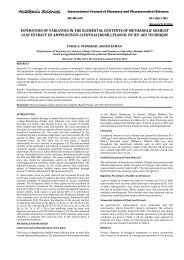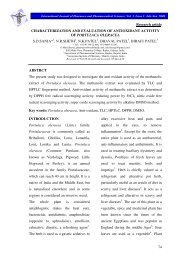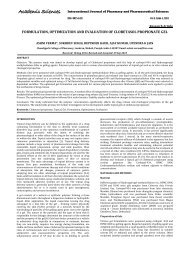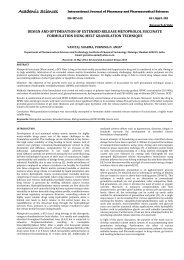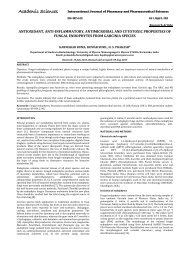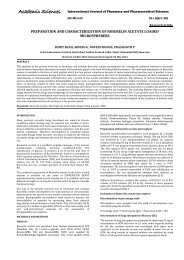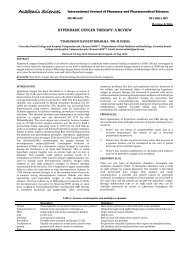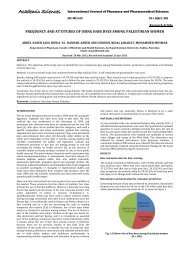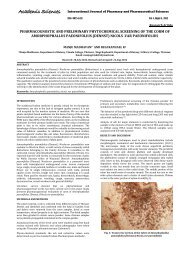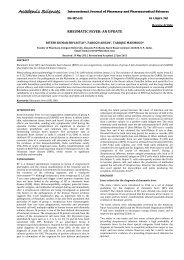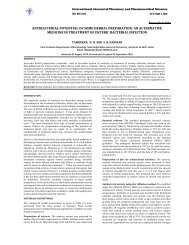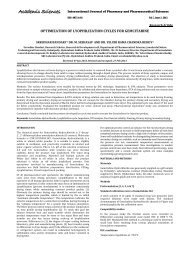study of antidiabetic and free radical scavenging activity
study of antidiabetic and free radical scavenging activity
study of antidiabetic and free radical scavenging activity
Create successful ePaper yourself
Turn your PDF publications into a flip-book with our unique Google optimized e-Paper software.
Research Article<br />
STUDY OF ANTIDIABETIC AND FREE RADICAL SCAVENGING ACTIVITY OF THE SEED<br />
EXTRACT OF STRYCHNOS NUXVOMICA<br />
V.CHITRA, * VENKATA.K.R.CH.H.VARMA.P, M.V.R.KRISHNA RAJU, K. JEYA PRAKASH<br />
Department <strong>of</strong> Pharmacology, SRM College <strong>of</strong> Pharmacy, SRM University, Kattankulathur, Kanchipuram District603203, Tamilnadu,<br />
India.E mail : velchitram@yahoo.com<br />
ABSTRACT<br />
The Present investigation was carried out to <strong>study</strong> the <strong>antidiabetic</strong> <strong>and</strong> antioxidant effects <strong>of</strong> the methanolic extract <strong>of</strong><br />
Strychnos nuxvomica in alloxan induced diabetic model. The <strong>antidiabetic</strong> <strong>activity</strong> <strong>of</strong> the methanolic extract <strong>of</strong> Strychnos<br />
nuxvomica was evaluated in normal & alloxan induced diabetic rats. Increased body weight <strong>and</strong> decreased blood<br />
glucose level <strong>of</strong> the test animals shows that the extract exhibited significant <strong>antidiabetic</strong> <strong>activity</strong> when compared to<br />
diabetic control group. The results also indicated dose dependent effect. The <strong>antidiabetic</strong> <strong>activity</strong> produced by the<br />
extract may be due to increased uptake <strong>of</strong> glucose at the tissue level or by an increase in pancreatic beta cell function<br />
or due to inhibition <strong>of</strong> intestinal absorption <strong>of</strong> glucose.<br />
The extract also produces a significant increase in Super Oxide Dismutase(SOD), Catalase & Total Protein(TP) level<br />
<strong>and</strong> decrease in Lipid Peroxidation(LPO), Total cholesterol, serum creatinine & Blood Urea Nitrogen(BUN) level in<br />
alloxan induced diabetic rats, which clearly show the antioxidant property <strong>of</strong> the extract. In vitro antioxidant <strong>study</strong> <strong>of</strong><br />
the methanolic extract <strong>of</strong> Strychnos nuxvomica was done by DPPH assay in which the percentage <strong>scavenging</strong> <strong>activity</strong> <strong>of</strong><br />
methanolic extract <strong>of</strong> Strychnos nuxvomica was gradually increased. The <strong>study</strong> indicated that the methanolic extract <strong>of</strong><br />
Strychnos nuxvomica is a potential <strong>antidiabetic</strong> <strong>and</strong> antioxidant agent <strong>and</strong> lends scientific support for its use in folk<br />
medicine.<br />
Keywords: Diabetes mellitus, Strychnos nuxvomica, antioxidant property, DPPH<br />
INTRODUCTION<br />
Despite the great efforts that have been made in<br />
underst<strong>and</strong>ing the management <strong>of</strong> diabetes, <strong>and</strong><br />
disease related complications are increasing unabated 1 .<br />
In spite <strong>of</strong> the presence <strong>of</strong> known <strong>antidiabetic</strong><br />
medicine in the pharmaceutical market, remedies from<br />
medicinal plants are used with success to treat this<br />
disease 2. Many traditional treatments have been<br />
recommended in the complementary <strong>and</strong> alternative<br />
system <strong>of</strong> medicine for treatment <strong>of</strong> diabetes mellitus 3.<br />
Diabetes mellitus is one <strong>of</strong> the major health problems<br />
in the world today .The incident <strong>of</strong> diabetes is affecting<br />
people from all walks <strong>of</strong> life.<br />
Diabetes mellitus (DM) comprises a group <strong>of</strong> metabolic<br />
disorders that share the phenotype <strong>of</strong> hyperglycemia.<br />
Several distinct types <strong>of</strong> DM exist <strong>and</strong> are caused by a<br />
complex interaction <strong>of</strong> genetics, environmental factors<br />
<strong>and</strong> life style choices. The metabolic deregulation<br />
associated with DM causes secondary pathophysiological<br />
changes in multiple organ systems, which are<br />
associated with oxidative stress <strong>and</strong> damage to tissues<br />
.Excessive generation <strong>of</strong> <strong>free</strong> <strong>radical</strong>s on unsaturated<br />
fatty acids has been implicated in the pathogenesis <strong>of</strong><br />
International Journal <strong>of</strong> Pharmacy <strong>and</strong> Pharmaceutical Sciences<br />
Vol 2, Suppl 1, 2010<br />
vascular diseases <strong>and</strong> the normal anti oxidant defense<br />
mechanism is insufficient in the regulation <strong>of</strong> this<br />
increased oxidative stress .Hence antioxidants from<br />
other sources are to be provided to counteract the<br />
oxidative stress 4.<br />
Strychnos nuxvomica Linn (Loganiaceae) is a medium<br />
sized tree, both wild <strong>and</strong> cultivated, throughout the<br />
India. The plant is popularly known as Snake wood in<br />
English. In the Indian system <strong>of</strong> medicine, the<br />
medicinal attribution <strong>of</strong> this species has be known for<br />
long time. As per the traditional claims ,the root bark is<br />
used in cholera ,leaves used in chronic wounds <strong>and</strong><br />
ulcers, <strong>and</strong> seeds used as appetizer, antiperiodic,<br />
purgative, asthma, diabetes, skin diseases 5 etc,.<br />
Phytochemically the plant has been reported to<br />
contain alkaloids like Strychnine ,brucine, <strong>and</strong><br />
strychnicine <strong>and</strong> glycosides like loganin, caffeotannic<br />
acid <strong>and</strong> also traces <strong>of</strong> copper 6,7. In pharmacology, only<br />
few activities such as analgesic 8 , apoptotic effect,<br />
antidepressant 9 antidote for snake poisoning 10<br />
antitumor 11 has been proved. Hence the present <strong>study</strong><br />
was undertaken to evaluate is potential against<br />
Diabetes <strong>and</strong> Free <strong>radical</strong> <strong>scavenging</strong> <strong>activity</strong>.<br />
106
Materials <strong>and</strong> Methods<br />
Plant material<br />
Strychnous nux vomica seeds were collected from<br />
Tambaram, Tamilnadu state in the month <strong>of</strong> January.<br />
Botanical identification was done by Pr<strong>of</strong>. P.J<br />
ayaraman, Director, Plant Anatomy Research Centre,<br />
Medicinal plant research unit, West Tambaram,<br />
Chennai.<br />
Extraction procedure<br />
The seeds were dried at room temperature until they<br />
were <strong>free</strong> from moisture. The seeds were then<br />
subjected to size reduction to get coarse powder <strong>of</strong><br />
desired particle size. The coarse powder was then<br />
stored in a clean dry air tight container. The powdered<br />
material was first subjected to defattation by soxhlet<br />
apparatus using petroleum ether for 15 hrs. Then the<br />
maceration was subjected to extraction by soxhlet<br />
apparatus with methanol for 48 hrs.The obtained<br />
extract was finally dried at low temperature under<br />
reduced pressure in a rotary evaporator crude powder<br />
was obtained <strong>and</strong> used to prepare suspensions<br />
0.16mg/kg concentration using water:Tween 80<br />
(4:1)for treatment.<br />
Drugs<br />
Alloxan was obtained from Sisco Research Lab pvt.Ltd,<br />
Mumbai, India .All other chemicals used for this <strong>study</strong><br />
were <strong>of</strong> analytical grade<br />
Animals<br />
Albino rats (wistar stain) <strong>of</strong> either sex were utilized for<br />
employed in this <strong>study</strong>. The rats were maintained<br />
under st<strong>and</strong>ard laboratory conditions at<br />
25±2ºC,relative humidity 50±15%<strong>and</strong> normal photo<br />
period (12 hr dark <strong>and</strong> 12hr light) were used for the<br />
experiment .Commercial pellet diet <strong>and</strong> water were<br />
provided ad libitum. The experimental protocol has<br />
been approved by the institutional animal ethics<br />
committee, proposal number being IAEC.19/2008.<br />
Effects <strong>of</strong> Strychnos nux vomica seed Extracts on<br />
Alloxan Induced Diabetes Mellitus<br />
Diabetic mellitus in rats was induced by intra<br />
peritoneal injection <strong>of</strong> Alloxan 50 mg/kg dissolved in<br />
1% citrate buffer (pH‐ 4.5) in male albino rats fasted<br />
for 12 hours. Animals are considered to be diabetic if<br />
they had plasma glucose level <strong>of</strong> 240 mg/dl in addition<br />
to polyuria, hyperphagia <strong>and</strong> decrease in body weight.<br />
After 96 hours <strong>of</strong> Alloxan injection, 1 ml <strong>of</strong> blood<br />
sample was withdrawn from animals by sinocular<br />
puncture under anaesthetized condition in tubes<br />
containing potassium oxalate <strong>and</strong> sodium fluoride as<br />
anticoagulant <strong>and</strong> plasma glucose level was<br />
determined using commercially available GOD POD Kit<br />
using auto analyzer.<br />
Animals were grouped according to the approximately<br />
same plasma glucose level <strong>and</strong> body weight. The<br />
Wistar rats were divided into four groups:<br />
Group I: Normal control rats received distilled water<br />
Group II: Diabetic control rats received Alloxan<br />
(120mg/kg)<br />
Group III: Diabetic rats received Strychnos nux vomica<br />
seed extract (0.16mg/kg) for three weeks from the<br />
third day <strong>of</strong> Alloxan treatment.<br />
Group IV: Diabetic rats received st<strong>and</strong>ard drug<br />
Glipizide (0.5mg/kg) for three weeks from the third<br />
day <strong>of</strong> Alloxan treatment.<br />
At the end <strong>of</strong> experiment rats were fasted overnight<br />
<strong>and</strong> scarified by cervical decapitation. Blood is<br />
collected; plasma <strong>and</strong> serum were obtained <strong>and</strong> used<br />
for determination <strong>of</strong> various biochemical parameters<br />
like Blood glucose level, total protein, Total<br />
cholesterol, Serum creatinine & Blood urea nitrogen.<br />
The liver was carefully removed, homogenized <strong>and</strong> the<br />
homogenate was used for the estimation <strong>of</strong> Lipid per<br />
oxidation, Super Oxide Dismutase & Catalase level.<br />
Body weight was noted on the day“0” <strong>and</strong> on the day<br />
“21”.<br />
Statistical analysis<br />
Results were expressed as mean ± S.E.M. The<br />
significance <strong>of</strong> the data was evaluated using ANOVA<br />
<strong>and</strong> were considered statistically significant when<br />
P
obtained using Richer(Austria) ultra tome <strong>and</strong> stained<br />
in toludine blue 0. Also appropriate regions were<br />
chosen for ultra structural <strong>study</strong>.<br />
RESULTS<br />
In the present <strong>study</strong>, the <strong>antidiabetic</strong> <strong>activity</strong> <strong>of</strong><br />
methanolic seed extract <strong>of</strong> Strychnos nux vomica was<br />
evaluated in normal & Alloxan induced diabetic rats.<br />
The effects <strong>of</strong> Strychnos nux vomica extract on body<br />
weight are summarized in Table 1, in which there is<br />
significant increase (P>0.05) in drug treated animals<br />
when compared to diabetic control. Table 2 shows the<br />
effect <strong>of</strong> methanolic seed extract <strong>of</strong> Strychnos nux<br />
vomica on blood glucose level in Alloxan induced<br />
diabetic rats. Diabetic rats treated with methanolic<br />
seed extract at doses <strong>of</strong> 100 <strong>and</strong> 200 mg/kg showed<br />
significant decrease in blood glucose level at 2 nd <strong>and</strong><br />
3 rd week from initial levels (P
DISCUSSION<br />
It was observed that, treatment <strong>of</strong> diabetic rats with<br />
Strychnos nux vomica, had not only shown a significant<br />
<strong>antidiabetic</strong> <strong>activity</strong> but also possess an effective<br />
antioxidant <strong>activity</strong> which an evident from the<br />
observations.<br />
Diabetes inducing agents like Alloxan <strong>and</strong><br />
Streptozotocin are reported to induce diabetes with<br />
generation <strong>of</strong> <strong>free</strong> <strong>radical</strong>s; a significant reduction in<br />
antioxidant enzyme levels is indicated as the potential<br />
reason for the susceptibility <strong>of</strong> organs to atrophy in<br />
diabetic states 13.<br />
Alloxan induced diabetes by destroying β‐cells <strong>of</strong><br />
pancreas, through production <strong>of</strong> reactive oxygen<br />
species. In Alloxan induced diabetic rats, increased<br />
food consumption <strong>and</strong> decreased body weight were<br />
observed. This indicates polyphagic condition <strong>and</strong> loss<br />
<strong>of</strong> weight due to excessive break down <strong>of</strong> tissue<br />
proteins. Strychnos nux vomica seed extract improved<br />
the glucose tolerance in Alloxan induced diabetes in<br />
rats as compared to control; the alcoholic extract<br />
shows dose dependent effect, <strong>and</strong> 0.16mg/kg dose<br />
shows reduction in glucose level. Strychnos nux vomica<br />
extract show significant reduction in blood urea <strong>and</strong><br />
creatinine in treated rats as compared to diabetic rats<br />
but significantly increased protein level.<br />
Possible sources <strong>of</strong> oxidative stress <strong>and</strong> damage to<br />
proteins in diabetes induced <strong>free</strong> <strong>radical</strong>s generated by<br />
autoxidation reactions <strong>of</strong> sugars <strong>and</strong> sugar adducts to<br />
protein <strong>and</strong> by autoxidation <strong>of</strong> unsaturated lipids in<br />
plasma <strong>and</strong> membrane proteins The oxidative stress<br />
may be amplified by a continuing cycle <strong>of</strong> metabolic<br />
stress, tissue damage, <strong>and</strong> cell death, leadind to<br />
increased <strong>free</strong> <strong>radical</strong> production <strong>and</strong> compromised<br />
<strong>free</strong> <strong>radical</strong> inhibitory <strong>and</strong> scavenger systems 14.<br />
Lipid Per oxidation is a <strong>free</strong> <strong>radical</strong> mediated oxidative<br />
to poly unsaturated fatty acids involving several types<br />
<strong>of</strong> <strong>free</strong> <strong>radical</strong> <strong>and</strong> termination occurs through<br />
enzymatic means or by <strong>free</strong> <strong>radical</strong> <strong>scavenging</strong> by anti<br />
oxidants. Under condition <strong>of</strong> severe oxidative stress,<br />
<strong>free</strong> <strong>radical</strong> generation leads to protein modification<br />
.proteins may be damaged directly by specific<br />
interactions <strong>of</strong> oxidants <strong>free</strong> <strong>radical</strong>s with particular<br />
susceptible amino acids. The level <strong>of</strong> total plasma<br />
protein was found to be decreased in this <strong>study</strong>. This<br />
could be due to increased Peroxidation in the diabetic<br />
rats .Strychnos nux vomica extract significantly<br />
reduced the elevated LPO <strong>and</strong> significantly improved<br />
SOD <strong>and</strong> CAT15 <strong>activity</strong><br />
In histopathological <strong>study</strong> the light microscopic<br />
photograph islet from control rat appeared circular<br />
with granulated beta cells appearing darker .Small &<br />
shrinken islets &destruction <strong>of</strong> beta cells were<br />
observed in the diabetic condition well formed islets<br />
increased cell number observed in diabetic rats<br />
In diabetes, there is a relation between glucose<br />
homeostasis, lipid metabolism later renal function <strong>and</strong><br />
enzyme activities. It was found that a 21 day<br />
administration <strong>of</strong> Strychnos nux vomica seeds shows<br />
equal effectiveness in controlling diabetics when<br />
compared with diabetics rats treated with st<strong>and</strong>ard<br />
drug (Glipizide). Methanolic extract <strong>of</strong> Strychnous nux<br />
vomica seed proved to have hypoglycemic effect on<br />
Alloxan induced diabetic rats; a fact indicated that<br />
there was a repair/regeneration <strong>of</strong> the beta cells <strong>of</strong> the<br />
islets <strong>of</strong> langerhans. As a result there was a increase in<br />
insulin level, which brought a homeostasis in the<br />
above mentioned biochemical parameters such as<br />
cholesterol, urea, creatinine total protein, <strong>and</strong> in the<br />
enzyme activities.<br />
CONCLUSION<br />
The present <strong>study</strong> indicated a significant anti diabetic<br />
effect <strong>of</strong> the methanol seed extract <strong>of</strong> Strychnos nux<br />
vomica <strong>and</strong> support its traditional usage in the control<br />
<strong>of</strong> diabetes. It is also shown strong anti‐oxidant<br />
potential <strong>activity</strong> by in vivo studies.<br />
ACKNOWLEDGMENT<br />
Authors are grateful to Dr. R. Shivakumar, Pro‐Vice‐<br />
chancellor, SRM University, Dr. K. S. Lakshmi, Dean,<br />
College <strong>of</strong> Pharmacy, SRM University, <strong>and</strong> Dr. K. Ilango<br />
Vice‐Principal, College <strong>of</strong> Pharmacy, SRM University,<br />
Kattankulathur, for providing necessary facilities to<br />
carry out this work.<br />
REFERENCES<br />
1. Ashok K.Tiwari <strong>and</strong> J.Madhusudana Rao. “Diabetes mellitus <strong>and</strong><br />
multiple therapeutic approaches <strong>of</strong> phytochemical: present<br />
status <strong>and</strong> future prospectus”. Current science 2002; 83:30‐38.J<br />
Appl.Sci.Res.,3(10):1073‐1083,20071081<br />
2. Bhattaram,V.A, M.Ceraefe,C.Kohlest, M.Vest <strong>and</strong><br />
H.Deundr<strong>of</strong>,2002.pharmocokinetics <strong>and</strong> bioavailability <strong>of</strong><br />
3.<br />
herbal medicinal products .Phytomed.,9:1‐36<br />
Complementary medicine is booming world wide ,1996.British<br />
medicinal journal.,313:131‐3<br />
4. C.H.Jithendra, P.Muralidharan “Anti‐hyperglycemic <strong>and</strong><br />
antioxidant activities <strong>of</strong> the ayurvedic drug Nisha<br />
5.<br />
kathakathadhi churnam in alloxan –induced hyperglycemic<br />
rats”. International journal <strong>of</strong> Green pharmacy; Jan‐March<br />
2009:66<br />
Goshi S.G, “Medicinal plant”1st Edition, page no. 361‐362<br />
6. Wu W,Qiao C, Liang Z,Xu H, Zhao Z. Cia Z, Alkaloid pr<strong>of</strong>iling in<br />
crude <strong>and</strong> processed Strychnous nux‐vomica seeds by matrix –<br />
assisted laser desorption /ionization‐ time <strong>of</strong> flight mass<br />
spectroscopy. J Pharm Biomed Anal.2007 Nov5; 45(3):430‐436.<br />
7. Yang XW, Yan ZK: Studies on the chemical constituents <strong>of</strong><br />
alkaloids in seeds <strong>of</strong> Strychnous nuxvomica Linn. Chin‐Mater‐<br />
Med –Zhongguo‐Zazhi; 1993; 18(12); 739‐740.<br />
109
8. Yin W, Wang TS, Yin FZ, Cai BC. Analgesic <strong>and</strong> anti<br />
inflammatory properties <strong>of</strong> brucine <strong>and</strong> brucine N‐oxide<br />
extracted from seeds <strong>of</strong> Strychnous nux‐vomica .J<br />
Ethnopharmacol.2003 Oct; 88(2‐3):205‐214.<br />
9. Yarnell‐E; Abascal‐K: Botanical treatments for depression. Part<br />
2. Herbal corrections for mood imbalances Alternative <strong>and</strong><br />
complimentary therapies; 2001; Jun6; 138‐143.<br />
10. M.Grieve, A moderen herbal medicine, Poisons <strong>and</strong> Antidotes.<br />
Steadmen Shorters Medical dictionary. 2007 Nov5; 91‐96.<br />
11. Deng X,Yin W, li WD, Yin FZ, Lu XY, Zhang XC, Hua ZC, Cai BC.<br />
The anti‐tumor effects <strong>of</strong> alkaloids from the seeds <strong>of</strong><br />
Strychnous nux‐ vomica on hepG2 cells <strong>and</strong> its possible<br />
mechanism. J Ethanopharmacol.2006 Jun 30; 106(2):179‐<br />
186.Epub 2006 Jan 26.<br />
12. J.V.Kavitha, Joseph F.Rosaria, Ch<strong>and</strong>ran J, Anbu P <strong>and</strong><br />
Bakkiyanathan “Hypoglycemic <strong>and</strong> other related effects <strong>of</strong><br />
Boswellia Gabra in Alloxan – Induced Diabetic Rats. “Indian J.<br />
physiol Pharmacol 2007; 51(1); 31<br />
13. Szkudelski T.P.A., Physiol.Res. 1999,50,536.<br />
14. JW Baynes, “Role <strong>of</strong> oxidative stress in development <strong>of</strong><br />
complications in diabetes” diabetes; 1991; 40; 405‐412.<br />
15. Sinha AK “Colorimetric assay <strong>of</strong> catalase”Anal Biochem 1972;<br />
47:389‐394.<br />
110



